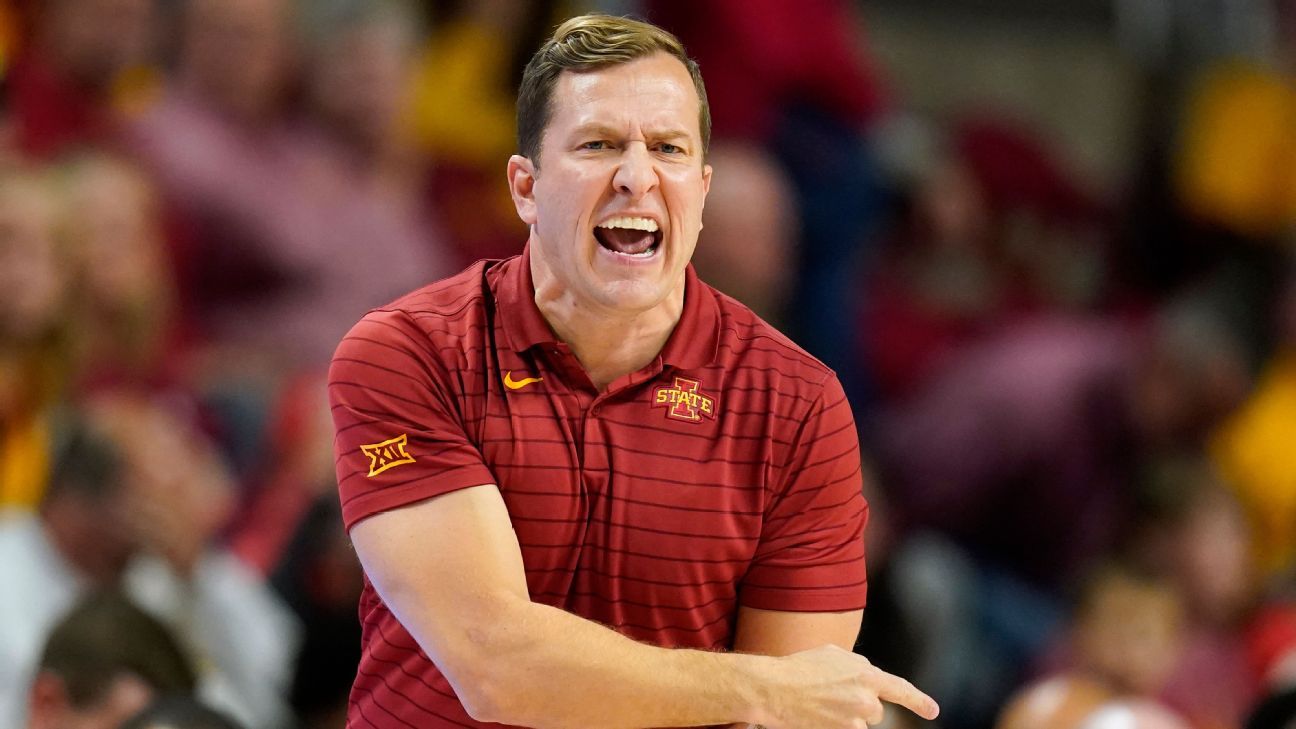Entering last week’s NIT Season Tip-Off in Brooklyn, Iowa State was viewed as the clear-cut fourth team in the field. Three top-25 teams — Memphis, Virginia Tech, Xavier — battling for the championship and the Cyclones there to round out the field.
By the end of the week, Iowa State was the highest-ranked member of the foursome in ESPN’s Power Rankings and slotted at No. 19 in the AP poll.
Given that Iowa State won two games all of last season and the Cyclones have tripled that total within three weeks, it’s an understatement to say everything is a little ahead of schedule for new head coach TJ Otzelberger and his team.
“I’m happy for our guys because we are very demanding,” Otzelberger said last week. “They know they are committed to a process that probably requires as much work and commitment as anybody does … We do the same thing every day. We have our routine. Hopefully we get lost in that work, keep our head down and keep growing as a team. We’re 6-0, but that also means we’re six games into a regular season with 31 games, so there’s a lot of season in front of us.”
Not only was Otzelberger taking over a team that went 2-22 overall and 0-18 in Big 12 play last season, he also needed to revamp the roster from a personnel perspective. Four starters from last season transferred, including Javan Johnson in late August, and senior Solomon Young also moved on.
So for a team with four transfers and one freshman in its top six, building chemistry and getting everyone on the same page quickly in the offseason was critical.
“I feel like the cohesiveness started in the summertime when we first met each other,” freshman Tyrese Hunter said. “It was just little things like making sure we all eat breakfast before practice together, making sure we all had a team meeting at the end of every day. Making sure we had team activities going out together — things that help you get to know the guys next to you faster. We had so many new guys and that was really big.”
Hunter has been one of the revelations of the first month of the season. A top-50 recruit in the 2021 class, Hunter reopened his recruitment following Steve Prohm’s firing last spring — but would recommit to Iowa State a month later.
Through seven games, Hunter is averaging 13.2 points, 3.7 rebounds, 5.2 assists and 3.2 steals.
“It’s a credit to his character and his work ethic certainly, because he’s somebody that comes every day,” Otzelberger told ESPN following Iowa State’s win over Xavier. “He gets extra work and he watches extra film. He wants to be great. He has pride in the job that he does even though he’s young – just turned 18. … You can never really say as a coach we knew what would happen coming into the night, but what I can say is I’ll always be confident in guys that do extra and have that pride like Tyrese.”
With Hunter at the head of the defense, Otzelberger has increased the aggressiveness at that end of the floor, looking to force more turnovers and get baskets in transition. The Cyclones are attacking the basket at a more frequent clip than last season, getting to the free-throw line and putting opposing defenses on their heels. They were picked last in the Big 12 in the preseason, but ISU is going to be competitive most nights — mostly due to its guards. Hunter has been fantastic, but Big Ten transfers Izaiah Brockington (Penn State) and Gabe Kalscheur (Minnesota) have made an immediate impact. Brockington had 30 points against Xavier, while Kalscheur went for 30 against Memphis. “Iowa State basketball’s program is just about being you — and they trust you to be you on the court,” Brockington said last week. “We’re all about the magic, so just going out there and having fun.”
1:46
The Wildcats upset the Wolverines 80-62 behind 22 points from Christian Koloko.
Tommy Lloyd has Arizona as a Pac-12 threat earlier than expected
There were supposed to be growing pains for Tommy Lloyd and Arizona.
When ESPN went to Tucson in the fall to see how the Wildcats were progressing, there was clearly talent on the roster, but it looked like it was going to take some time for Lloyd’s faster, more European-style system to click. Well, the system has changed, but it has been a fairly seamless transition since the season began.
Arizona is playing at a top-20 tempo nationally, faster than the Wildcats have played since Lute Olson was at the helm. They rank No. 1 in the country in percentage of baskets assisted and at the other end they’re No. 1 nationally in field-goal percentage defense.
Lloyd, who took over for Sean Miller after 20 years as an assistant coach at Gonzaga, credits the team mostly sticking around in Tucson during the summer for the fast start and quick adaptation to the new style.
“Pretty much everybody got their eight weeks in, and I was putting in the building blocks of the system all summer. It wasn’t just shooting and ball-handling. It was team basketball,” Lloyd told ESPN on Wednesday. “Where I’ve been excited, during games where there’s live reps, our guys have learned from them. Things we’ve done right we’ve been able to reinforce, things we’ve done wrong we’ve been able to address. They’ve been pretty quick learners. That’s what’s been positive for me, how quickly they learn and adapt.”
The game that opened everyone’s eyes about Arizona this season was its 18-point blowout of then-No. 4 Michigan in Las Vegas at the Roman Main Event. The Wildcats got a bit of separation on the Wolverines toward the end of the first half and then put the game out of reach in the first five minutes of the second half. Pulling away in the second half was a stark contrast to the two days prior, when Arizona blew a 16-point second-half lead to Wichita State before pulling out a win in overtime.
“We wanted to come out in that game in attack mode,” Lloyd said of the Michigan win. “We didn’t want to sit back and let them dictate the terms. We wanted to pressure the ball, break them out of their stuff. We wanted to see, how do they play outside of their sets? And offensively, we wanted to move them, really challenge them to guard multiple pick-and-rolls. There were positives from that Wichita State experience. Some of our passing, ball-handling, decisions weren’t up to par. So we could say, this is what it looks like when you do it right, this is what it looks like when you do it wrong.”
Projected first-round pick Bennedict Mathurin has lived up to the hype, returning big man Azuolas Tubelis has taken the next step in his development and Kerr Kriisa has been terrific at the point guard spot. But the big story in Tucson this season has been Christian Koloko, the 7-foot-1 Cameroon native who has played himself onto NBA draft boards with a breakout junior campaign.
After averaging 5.3 points, 4.8 rebounds and 1.3 blocks last season, Koloko is putting up 16.2 points, 7.5 rebounds and 3.5 blocks this season, while shooting 69.2% from the field. He also won his head-to-head matchup against preseason All-American Hunter Dickinson of Michigan, going for 22 points, seven rebounds and four blocks while Dickinson struggled with 11 points on 4-for-10 shooting.
“This offseason, Christian really committed to getting better,” Lloyd said. “We started with the basics, finishing, making layups, balance. Attacking it like that. He really worked hard; he didn’t go anywhere this summer. He started to make progress, and as he started to make progress, he gained confidence. I don’t think he knew how good he was getting. His teammates started seeing the progress; everybody’s like, we got a player here.”
Arizona is off to a 6-0 start, but the schedule is about to get tougher in December. Pac-12 play begins this week against Washington and Oregon State, while road trips to Illinois, Tennessee, UCLA and USC are also on the docket over the next four weeks.
Lloyd is happy about the hot start, but he doesn’t want to peak in the first month of his first year as a head coach.
“It’s reinforced that we’re doing the right things. And when we’re doing the right things, they work,” he said. “But this is my first time through this journey. My guard’s not coming down. I’ve been communicating that to the players. We’re not going to take anything for granted.”
0:34
Tyler Kolek steals the ball and takes it the other way for the basket and a foul to give Marquette the lead with 17 seconds left.
New high-major coaches and other notables
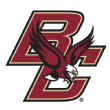
Earl Grant, Boston College Eagles: Unsurprisingly, it’s been a difficult first month for Grant, who took over for Jim Christian. The Eagles have already surpassed the number of wins Boston College had last season after beating South Florida by 15 on Monday, but that victory over the Bulls was the best of their five victories thus far. They lost their three most difficult games, two to Rhode Island and one to Utah. The most noticeable difference from last season thus far is the pace: Boston College’s tempo is in the bottom 30 nationally thus far, after ranking No. 58 in the country in 2020-21.

Wes Miller, Cincinnati Bearcats: Miller’s first order of business at Cincinnati was to convince the players who had entered the transfer portal following the season to return under the new head coach. Next, it was to get the Bearcats to defend like they had a few years prior. After ranking in the top 50 nationally in adjusted defensive efficiency for the final 10 years of Mick Cronin’s tenure, they almost dipped outside the top 100 last season, ranking eighth in the AAC. It’s working so far. Cincinnati hasn’t allowed a single opponent to score 1.00 point per possession this season, and the Bearcats have wins over Georgia and Illinois on the ledger, as well as a narrow loss to Arkansas. The home loss to Monmouth last weekend takes some of the shine off Miller’s start at Cincinnati, but there’s promise through one month.

Tony Stubblefield, DePaul Blue Demons: There’s some optimism surrounding the Blue Demons after getting off to a 6-0 start in Stubblefield’s first six games at the helm. All six games came at home, which should temper some of the expectations, but they did beat Rutgers in mid-November and are getting first-team all-league-caliber play from guard Javon Freeman-Liberty. Some true tests are coming up soon, with a city rivalry game against Loyola Chicago on Saturday and a trip to Louisville next week. Stubblefield has DePaul pushing the tempo and playing aggressively on the offensive end.

Desmond Oliver, East Tennessee State Buccaneers: Oliver has brought wins quickly to Johnson City, building on the talent base that Steve Forbes and then Jason Shay established for the Bucs. The former Tennessee assistant has already notched victories over Murray State, Missouri State and Kent State, winning the Naples Invitational in the process. From a stylistic perspective, there haven’t been dramatic changes. ETSU is shooting more 3s and sharing the ball better than last season, while also guarding the perimeter more effectively at the other end.
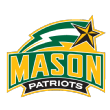
Kim English, George Mason Patriots: After four games, English looked like one of the most promising new head coaches in the country. The Patriots had dominated their first three games against mid-major competition and then went to College Park and knocked off Maryland. Since then, though, it’s been a struggle. Mason lost to James Madison and Washington and then was blown out by Nevada in South Dakota. A loss to South Dakota State capped off the four-game losing streak. But English’s impact has been felt from an offensive perspective, as the Patriots are shooting significantly more 3s than last season and have been more efficient at that end of the floor.

Mike Woodson, Indiana Hoosiers: Woodson has had an immediate impact on Indiana, especially on the defensive end of the floor. The Hoosiers rank first nationally in 2-point percentage defense and effective field goal percentage defense, and they’re more aggressive in terms of ball pressure and forcing turnovers in the half-court. Offensively, most of the success has come from new personnel. Indiana has improved point guard play with Pitt transfer Xavier Johnson and is shooting the ball significantly better, led by freshman Tamar Bates. And Trayce Jackson-Davis has been dominant. Indiana suffered its first loss of the season at Syracuse in double overtime on Tuesday.

Drew Valentine, Loyola Chicago Ramblers: As Porter Moser’s assistant for four seasons, Valentine was the obvious replacement for Moser after he left for Oklahoma. As a result, it’s not too much of a surprise that the Ramblers have looked similar from a stylistic standpoint. One noticeable difference has been the emphasis on perimeter production. Loyola is shooting more 3s per game and making them at a much higher clip than last season. Single-digit losses to Michigan State and Auburn were difficult, but the Ramblers bounced back with an 18-point victory over Arizona State.

Shaka Smart, Marquette Golden Eagles: The Golden Eagles were among the biggest stories in college basketball during the first week-and-a-half of the season, beating Illinois at home and then knocking off Ole Miss and West Virginia in the quarterfinals and semifinals of the Charleston Classic. They were then blown out by St. Bonaventure in the title game, but 7-1 with three wins over major-conference opposition is a terrific start for Smart. He’s playing much more HAVOC-like than he did at Texas, ranking in the top 10 nationally in tempo and looking to attack and play in transition. Marquette doesn’t play a team outside the top six conferences the rest of the season.
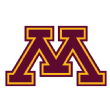
Ben Johnson, Minnesota Golden Gophers: It hasn’t been the stiffest competition, but part of getting early momentum on your side is stacking wins in the first month of the season — and Johnson and the Golden Gophers are doing that. They won their first six games of the season, including a couple neutral-site victories over Western Kentucky and Princeton to win the Asheville Championship and then a win over Pittsburgh in the Big Ten/ACC Challenge. Their offense isn’t as far along as the defense, which isn’t completely unexpected with so many new faces, but they’ve played disciplined defensively and have really competed on the perimeter.

Richard Pitino, New Mexico Lobos: Considering he took over a team that finished 2-15 in Mountain West play last season, early growing pains for Pitino and the Lobos shouldn’t be much of a surprise. They were off to a 4-1 start, with the lone defeat coming by 11 at Colorado — but then lost two in a row to UAB and Towson in Las Vegas before bouncing back with a road win over rival New Mexico State on Tuesday. Pitino’s biggest impact stylistically has come in tempo and aggressiveness defensively. New Mexico is top-25 nationally in pace and top-40 in defensive turnover percentage after ranking around 200 in tempo and outside the top 100 in turnover percentage last season.
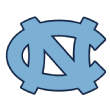
Hubert Davis, North Carolina Tar Heels: Davis has made an effort to change the style in Chapel Hill, going from the two-big men lineups that Roy Williams preferred to a more modern, four-in, one-out type of setup. It has had its ups and downs. The Heels have looked more difficult to defend at times, with Dawson Garcia and Brady Manek posing matchup problems and giving Caleb Love more room to maneuver with the ball in his hands. But they started the season really struggling defensively, allowing 87 points to Brown, 83 to Charleston, 84 to Purdue and 89 to Tennessee. Since the 0-2 trip to Mohegan Sun, though, the Tar Heels have turned things around at that end of the floor — highlighted by holding Michigan to 0.79 points per possession in Wednesday’s 21-point win.

Porter Moser, Oklahoma Sooners: The Sooners might be receiving a bit more attention nationally had they not suffered a three-point loss at the hands of Justin Bean and Utah State in the final of the Myrtle Beach Invitational. They’re now 7-1 after handing Florida its first loss of the season on Wednesday. Oklahoma has been outstanding at the rim through the first month of the season, although most of that has been due to the efficiency of Tanner Groves and Jalen Hill in the paint. The Sooners are third nationally in 2-point percentage, with Groves shooting 68.1% and Hill making 80.6% of his 2-point attempts. Those two combined for 38 points and 12 boards against the Gators.
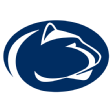
Micah Shrewsberry, Penn State Nittany Lions: It’s been a mixed bag for Shrewsberry and the Nittany Lions through the first few weeks. They suffered a 25-point loss at UMass in the second game of the season, but took unbeaten LSU to overtime and then handled Oregon State by 15 points before coming back home and falling to Miami. The biggest changes under Shrewsberry have come from a tempo perspective. The Nittany Lions rank near No. 350 nationally in pace, which is closer to the way Purdue — Shrewsberry’s previous program — plays than how Penn State played under Pat Chambers and Jim Ferry. Much of that stems from emphasizing a sound half-court offense. Once PSU gets the turnovers down, the offensive efficiency should improve.

Shantay Legans, Portland Pilots: Given the strength of schedule, it’s too early to get too excited about the Pilots, but they’ve already won seven games this season — after winning six games all of last season. The best win was probably over Portland State and one of the seven wins came against a non-Division I opponent, but at least there’s some promise for a Pilots program with nine losing seasons in their last 10. They’ve improved defensively up to this point in the season.

Chris Beard, Texas Longhorns: Given the recruiting class Beard was bringing into Austin this year, with six top-35 transfers and a top-50 freshman, there was always going to be a feeling-out period at the start of the campaign. Seven different players have started multiple games already this season and Vanderbilt transfer Dylan Disu isn’t even healthy yet. Beard’s team isn’t quite guarding like his previous groups, but some of that has to do with their game against Gonzaga in the second game of the season. Marcus Carr (8.5 PPG with just 18 made field goals in six games) has struggled after transferring in from Minnesota, but we expect he’ll find his footing.

Mark Adams, Texas Tech Red Raiders: Beard’s former assistant coach has done a solid job filling his shoes so far. Adams’ reputation is that of a defensive whiz and and even after the Red Raiders’ first loss of the season to Providence on Wednesday night, they are once again ranked in the top 20 nationally in adjusted defensive efficiency. Granted, Providence was their first opponent ranked inside the top 240 at KenPom and the Friars scored 1.04 points per possession in the comeback win. Stylistically, it’s been pretty similar for Texas Tech except for two key areas: offensive rebounding and 3-point shooting. Marcus Santos-Silva and Bryson Williams have been dominant on the glass and the addition of Kevin Obanor has allowed Tech to stretch teams a bit more in the frontcourt. Terrence Shannon Jr.‘s return has been a huge boost as well.

Mike Jones, UNC Greensboro Spartans: Jones was one of the better mid-major hires last spring, after winning at least 21 games five times in his final eight seasons at Radford, including an NCAA tournament appearance in 2018. And early on, he’s looking like a great replacement for Wes Miller, who had the Spartans in NCAA tournament contention in each of the last five seasons. This season, UNCG lost a pair of overtime games to UMass and FIU, but also beat Vermont and Northern Kentucky en route to a 7-2 start.

Kevin Kruger, UNLV Rebels: Few coaches hit the transfer portal as hard as Kruger and his staff did last spring, with four transfers in the Runnin’ Rebels’ starting lineup and seven in their 10-man rotation. Through one month, there have been some highs — three straight wins to start the season, including a victory over California — and some lows — three straight Division I losses since the 3-0 start. From a style and system standpoint, the most noticeable difference has been on the defensive end, where the Rebels rank more than 100 spots higher in adjusted defensive efficiency than last season. They’re contesting shots on the perimeter and forcing more turnovers. Offensively, they’re doing a much better job of taking care of the ball.

Craig Smith, Utah Utes: Smith and the Utes rolled through their first five games of the season, beating 2021 NCAA tournament participant Abilene Christian in the opener and then knocking off Boston College and Tulsa on back-to-back nights in Daytona Beach. They hung with in-state rival BYU for about 30 minutes, before a 16-3 run by the Cougars provided some separation. Their Pac-12 opener against USC on Wednesday didn’t go well, either, losing 93-73. One thing that has carried over from Smith’s days at Utah State is offensive rebounding; the Utes rank in the top-25 nationally after Utah State ranked No. 13 last season. There have been defensive improvements, more in line with what we saw at Utah State — which makes sense, given two of Smith’s starters in Logan are now starting for him in Salt Lake City.
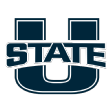
Ryan Odom, Utah State Aggies: Odom has had one of the best starts for any new coach so far this season. The Aggies had a three-point loss in the season opener to UC Davis, which raised eyebrows when it happened and looks even more like an anomaly given that UC Davis lost by 19 to Division II Academy of Art last weekend. But since then, Utah State has been terrific. The Aggies beat Oklahoma and Richmond, and went 4-0 at neutral sites — including a Myrtle Beach Invitational championship. Craig Smith led Utah State to three straight 20-win seasons and Odom might have them on their way to another one.
